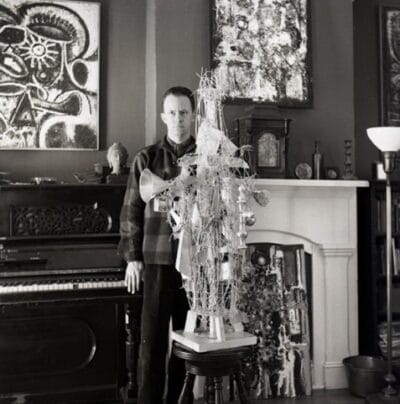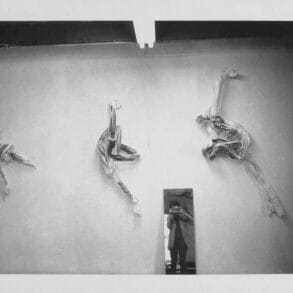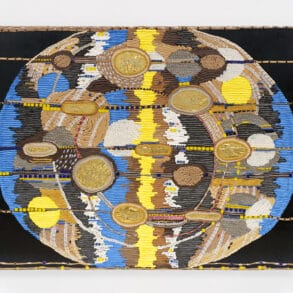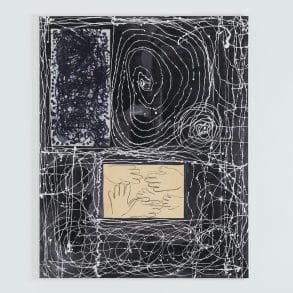New York – Pace is pleased to present an exhibition of works by Richard Pousette-Dart at its 510 West 25th Street gallery in New York. On view from November 11 to December 17, the presentation will spotlight Pousette-Dart’s paintings, sculptures, works on paper, and journals from the 1950s, a pivotal decade of the artist’s career during which he moved from New York City to Rockland County, located in the Lower Hudson River Valley of New York state. The works in Pace’s upcoming exhibition—which is curated by Joanna Pousette-Dart, the artist’s daughter— have never been shown together. Holistically, the presentation offers an unprecedented, in-depth look at a protean period in which Pousette-Dart’s painterly investigations were directed toward the extremes of color, light, and physical density, further amplified by his multidisciplinary practice that included sculpture and photography. This exhibition presents seemingly dissimilar but deeply interconnected bodies of work, unified by their underlying structures and additive processes, to immerse viewers in the artist’s expansive vision.

On the occasion of the exhibition, Pace Publishing will produce a new catalogue featuring an interview between Joanna Pousette-Dart and curator Lowery Stokes Sims—who organized the Metropolitan Museum of Art in New York’s 1997 Pousette-Dart exhibition—as well as the text of a talk delivered by the artist at the School of the Museum of Fine Arts in Boston in 1951, published in its entirety for the first time.
The rich, varied works in Pace’s upcoming presentation, which diverge and converge in surprising ways, reflect the artist’s interest in cross-pollination among various mediums. These pieces also speak to the natural world’s profound influence on his artistic sensibility. Pousette-Dart’s 1950 move to New York’s Rockland County, which freed him from the confines of his smaller studio in the city, had a liberating effect on his art. Working in a new, spacious environment, the artist followed his ideas to unexpected conclusions, allowing his thought processes to interact across canvas, sculpture, and paper.
While he is widely known as a first-generation Abstract Expressionist painter, Pousette-Dart’s distinctive and richly inventive formal experimentations should be understood beyond that movement. Often exploring the spiritual and transcendental possibilities of art making through a personal philosophy and iconography of organic and biomorphic forms, Pousette-Dart built on his innovations of the 1930s and 1940s to draw inspiration from the beauty, complexity, and wholeness of nature, continuing to expand his vision over the following four decades of his practice.
“Art for me is the heavens forever opening up, like asymmetrical, unpredictable, spontaneous Kaleidoscopes,” Pousette-Dart said in his 1951 talk at the SMFA in Boston, which focuses on his artistic philosophy and working process. “It is magic, it is joy, it is gardens of surprise and miracle. It is energy, impulse. It is question and answer. It is transcendental reason. It is total in its spirit.”
The forthcoming exhibition at Pace, which has represented the artist’s estate since 2013, brings together some of the most iconic paintings created by Pousette-Dart during the 1950s, including loans from private collections as well as the Whitney Museum of American Art, the Museum of Modern Art, and the Brooklyn Museum in New York. These pieces will be shown alongside his work in other mediums, providing a deep and nuanced look at the breadth of his practice.
The exhibition will showcase a selection of the artist’s oneiric and ethereal White paintings—first shown at Betty Parsons Gallery in New York and later featured in the exhibition Pousette-Dart: Predominantly White Paintings at the Phillips Collection in Washington, D.C.—in which graphite lines are etched into layers of white, coalescing in intricate abstractions. These will be shown in juxtaposition with Pousette-Dart’s Gothic and Byzantine paintings, including the 1958 work Blood Wedding, to shed light on the artist’s investigations of intense color saturation and physicality. The wire and metal sculptures in the presentation, such as The Woman with a Horn (Wire Sculpture #4) (1951), are further manifestations of this cross-media conversation.
Archival materials in the exhibition will call attention to the way Pousette-Dart’s interest in photography informed his ideas about light and materiality. In addition to the paintings, wire sculptures, drawings, photographs, and notebooks on view in Pace’s exhibition, a group of pocket-sized brass sculptures will contextualize the featured works, underscoring the art historical richness of Pousette-Dart’s bold output and bringing into focus his process of synthesizing varied structures, forms, and materials. Presented in their own vitrine, the artist’s hand-cut, geometric brass sculptures, which he introduced into his practice in the late 1930s, directly relate to the paintings in the exhibition. The semi-abstract forms from Pousette-Dart’s brass works often figure in his works on canvas and paper, cultivating a sense of continuity across his practice.
Beyond Pace’s exhibition, Pousette-Dart’s artworks can be found in the collections of the Metropolitan Museum of Art, Solomon R. Guggenheim Museum, MoMA, and Whitney Museum in New York; the Los Angeles County Museum of Art; the San Francisco Museum of Modern Art; the National Gallery of Art and Hirshhorn Museum and Sculpture Garden in Washington, D.C.; the Peggy Guggenheim Collection in Venice; and other international institutions.
Richard Pousette-Dart (b. 1916, St. Paul, Minnesota; d. 1992, New York) is grouped with the first generation of Abstract Expressionist painters, although he took his own path throughout his long career, achieving a cohesive body of work with expressive form, color, and gesture. He participated in the pivotal Subjects of the Artists and Studio 35 groups, which were key to defining the New York School. Pousette-Dart was the first of these artists to create a mural- sized easel work (Symphony No. 1, The Transcendental, 1941–42, now at The Metropolitan Museum of Art, New York), prior to other Abstract Expressionists’ adoption of large formats. He drew inspiration from varied sources including Native American and Oceanic art, as well as Asian philosophy and American Transcendentalism. Never embracing action painting and instead pursuing his own aesthetic, Pousette-Dart aspired to universal significance in his art, expressed through nonobjective means.
Pace is a leading international art gallery representing some of the most influential contemporary artists and estates from the past century, holding decades-long relationships with Alexander Calder, Jean Dubuffet, Barbara Hepworth, Agnes Martin, Louise Nevelson, and Mark Rothko. Pace enjoys a unique U.S. heritage spanning East and West coasts through its early support of artists central to the Abstract Expressionist and Light and Space movements.
Since its founding by Arne Glimcher in 1960, Pace has developed a distinguished legacy as an artist-first gallery that mounts seminal historical and contemporary exhibitions. Under the current leadership of President and CEO Marc Glimcher, Pace continues to support its artists and share their visionary work with audiences worldwide by remaining at the forefront of innovation. Now in its seventh decade, the gallery advances its mission through a robust global program—comprising exhibitions, artist projects, public installations, institutional collaborations, performances, and interdisciplinary projects. Pace has a legacy in art bookmaking and has published over five hundred titles in close collaboration with artists, with a focus on original scholarship and on introducing new voices to the art historical canon.
The gallery has also spearheaded explorations into the intersection of art and technology through its new business models, exhibition interpretation tools, and representation of artists cultivating advanced studio practices. As part of its commitment to technologically engaged artists within and beyond its program, Pace launched a hub for its web3 activity, Pace Verso, in November 2021.
Today, Pace has nine locations worldwide, including a European foothold in London and Geneva, and two galleries in New York—its headquarters at 540 West 25th Street, which welcomed almost 120,000 visitors and programmed 20 shows in its first six months, and an adjacent 8,000 sq. ft. exhibition space at 510 West 25th Street. Pace’s long and pioneering history in California includes a gallery in Palo Alto, which operated from 2016 to 2022. Pace’s engagement with Silicon Valley’s technology industry has had a lasting impact on the gallery at a global level, accelerating its initiatives connecting art and technology as well as its work with experiential artists. Pace consolidated its West Coast activity through its flagship in Los Angeles, which opened in 2022. Pace was one of the first international galleries to establish outposts in Asia, where it operates permanent gallery spaces in Hong Kong and Seoul, as well as an office and viewing room in Beijing. Pace’s satellite exhibition spaces in East Hampton and Palm Beach present continued programming on a seasonal basis.
Pace Gallery
510 West 25th Street






